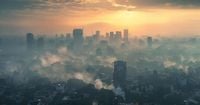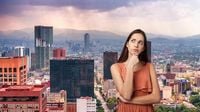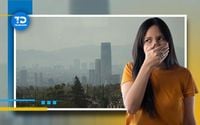On Thursday, April 10, 2025, Mexico City (CDMX) and the State of Mexico (Edomex) woke up to a partially cloudy sky, moderate winds, and no rain. As the day began, concerns about a potential environmental contingency loomed, particularly due to reports of poor air quality in several areas. With traffic intensifying and temperatures on the rise, many residents are left wondering whether additional restrictions will be imposed or if they should alter their outdoor activities.
The air quality today is reported as acceptable across most municipalities in the Mexico City metropolitan area (ZMVM), although areas such as Benito Juárez, Azcapotzalco, Coyoacán, Gustavo A. Madero, Iztacalco, Iztapalapa, Venustiano Carranza, Tláhuac, Tlalnepantla, and Tultitlán show elevated levels of pollutants. Consequently, sensitive groups—including children, the elderly, and individuals with respiratory conditions—are advised to limit intense physical activities outdoors, especially in the most affected areas.
According to the latest forecast for today, a dry and temperate environment is expected, with temperatures ranging from 11 to 27 degrees Celsius. Winds from the north, reaching up to 20 km/h with gusts, may assist in dispersing pollutants, although this effect may not be uniform across the city.
Under the "Hoy No Circula" program, vehicles with a green sticker, specifically those with plates ending in 1 and 2, and those with holograms 1 or 2 are prohibited from circulating today. Vehicles with holograms 00, 0, as well as electric and hybrid cars, are exempt from this restriction. Although no environmental contingency has been declared yet, the poor air quality in various zones calls for caution. Residents are urged to stay updated on official reports and prioritize their health, especially if they belong to vulnerable populations.
The Atmospheric Monitoring Directorate of Mexico City released its air quality report, indicating that as of 5:00 AM today, the overall air quality in both Mexico City and the State of Mexico is categorized as "Buena" (Good), with a "Bajo" (Low) health risk. The report emphasizes that individuals should consider this information when planning outdoor activities, particularly those involving sensitive groups. The UV index also reached a level of 0 today, suggesting that no sun protection is needed for outdoor exposure.
In terms of air quality, data from the 16 monitoring stations across Mexico City shows that areas like Tlalpan, Azcapotzalco, Coyoacán, Cuajimalpa, Gustavo A. Madero, Iztacalco, Venustiano Carranza, Miguel Hidalgo, Álvaro Obregón, Iztapalapa, and Tláhuac report good air quality. Similarly, the State of Mexico also sees good air quality in municipalities such as Atizapán, Chalco, Cuautitlán Izcalli, Naucalpan, Nezahualcóyotl, and Ecatepec.
As the ozone season progresses, which began in mid-February and is expected to last until June 2025, the likelihood of an environmental contingency increases due to the concentration of pollutants exacerbated by climatic conditions. Ozone, a significant air contaminant, forms through chemical reactions between carbon monoxide, nitrogen oxides, and volatile organic compounds in the presence of sunlight and high temperatures. This pollutant can cause irritation in the throat, nose, and eyes, and can worsen symptoms for individuals suffering from bronchitis, asthma, or emphysema.
The National Meteorological Service (SMN) has predicted maximum temperatures between 25 and 27 degrees Celsius for today, with skies ranging from clear to partly cloudy and no anticipated rainfall. By 8:00 AM, five mayoralties reported acceptable air quality with moderate health risks, including Gustavo A. Madero, Cuauhtémoc, Venustiano Carranza, Iztapalapa, and Tláhuac. In contrast, the remaining 11 mayoralties enjoyed good air quality, indicating a very low or no health risk.
As of 7:00 AM, the air quality was acceptable in Cuauhtémoc and Venustiano Carranza, while at 6:00 AM, the Atmospheric Monitoring System reported good air quality throughout the entire Mexico City area. This indicates a very low or no risk to health at that time.
The Secretariat of the Environment of Mexico City (Sedema) has been actively monitoring air quality, reporting that it varies significantly throughout the year due to factors like seasonality, weather conditions, and vehicular traffic. The most problematic pollutants identified in the region include PM10 and PM2.5 particles, ozone (O3), and nitrogen oxides (NOx). Traffic remains the primary source of air pollution, despite various initiatives like the "Hoy No Circula" program and vehicle inspections. The growth of the vehicle fleet and the use of fossil fuels continue to contribute significantly to pollutant emissions.
In light of air quality issues, the Commission for Environmental Protection of the Megalopolis recommends that during contingencies or periods of poor air quality, residents should avoid outdoor civic, cultural, and recreational activities, especially between 1:00 PM and 7:00 PM. Additionally, organized outdoor events should be postponed during these hours to protect public health.
According to the National Institute of Public Health, air pollution is responsible for thousands of premature deaths annually and contributes to a rise in respiratory and cardiovascular diseases. Vulnerable populations, including children, the elderly, and individuals with pre-existing health conditions, are particularly at risk. Public awareness and civic participation are essential in efforts to improve air quality. Non-governmental organizations and community movements have played a crucial role in promoting sustainable practices, such as cycling, reducing plastic consumption, and engaging in recycling programs.
Despite ongoing challenges, there is a concerted effort from both authorities and civil society to enhance air quality in Mexico City. Embracing clean technologies, strengthening public transport, and implementing stricter environmental policies are vital steps toward a more sustainable future.







